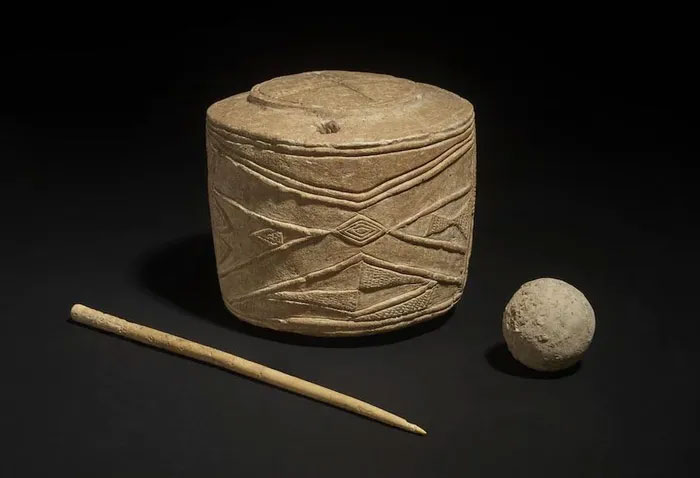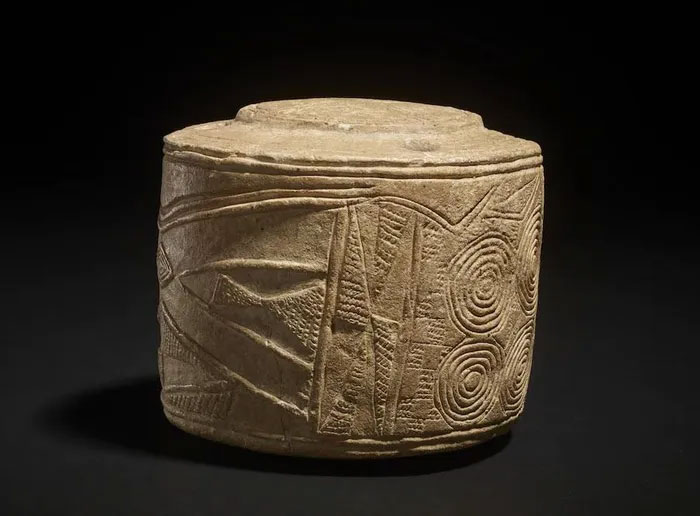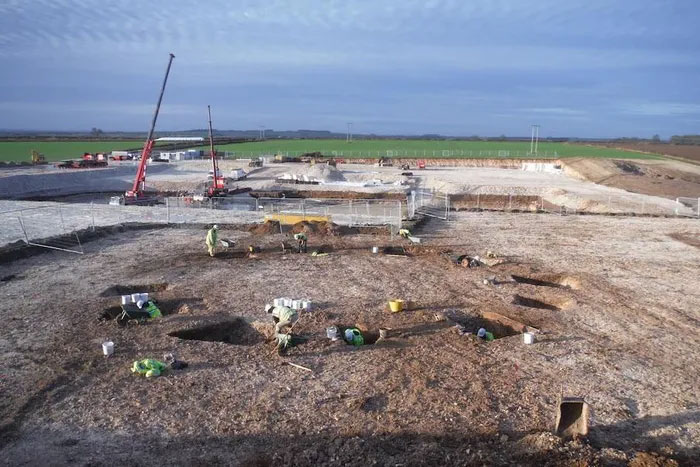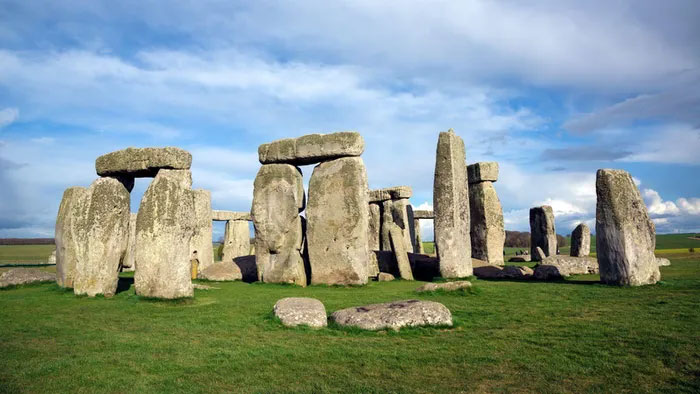British archaeologists recently discovered a 5,000-year-old drum alongside three sets of intertwined skeletal remains of children, as reported by The Washington Post on February 12.
It is neither made of bronze, iron, nor gold. This is one of the most intriguing relics, a sculpture shaped like a drum, carved from soft stone resembling chalk and adorned with mysterious symbols, lost to us since the time of Stonehenge.
The British Museum announced on February 12 that they have uncovered a 5,000-year-old sculpture, which they describe as the “most important prehistoric artwork found in England in the last 100 years.”
Archaeologists say this artifact holds profound significance, if only we could decode it. The relic was found in a grave containing the remains of three children, their bones intertwined like vines, according to Duncan Garrow, a professor of prehistory at the University of Reading in England, who has studied the object.
The chalk sculpture (referred to as a drum, although it is actually just a solid piece of carved stone) was discovered miles north of Stonehenge, on land that is now a rural estate near the village of Burton Agnes in East Yorkshire. The exact location of the excavation remains a secret.

The British Museum calls the drum, the chalk ball, and the bone pin “the most important prehistoric artwork found in England in the last 100 years.” (Photo: British Museum).
The Mystery of the Cause of Death
Mark Allen, founder of the archaeological consultancy Allen Archaeology, who discovered the grave and the drum, told The Washington Post that his team found the burial site containing the remains of three children, aged between 3 and 12.
The two youngest children faced each other, their noses touching, hands clasped tightly. The oldest child wrapped their arms around them. “The children were cuddling each other. It’s quite poignant to witness,” Allen remarked.
According to Allen, it seems that all three died at the same time. If scientists are lucky, they may recover usable DNA to determine if the three children were related. Allen wonders if the cause of death could have been a plague, a terrible accident, or drowning. “It seems something dramatic happened, prompting the community to bury the three children together in this way,” he noted.
There are no clear signs of trauma on the three sets of remains. So were they sacrificed? Professor Garrow stated: “The fact that three children died together raises eyebrows. But we do not know the cause.” He later mentioned that there is no evidence of violent acts leading to the children’s deaths.
Using radiocarbon dating, archaeologists have dated the grave to a period close to the construction of Stonehenge, between 3005 and 2890 BC. There is evidence that the grave was maintained for 1,000 years.

Three children were found with intertwined bones. (Photo: Allen Archaeology).
Top Ancient Artifact Mystery in England
More than a century ago, three other chalk sculptures—almost identical—were discovered about 15 miles from the latest excavation site, located in another grave that contained only one child.
Known as the “Folkton Drum”, excavated in 1889, they are “one of the most mysterious and famous ancient artifacts ever unearthed in England,” researchers say.
Neil Wilkin, curator at the British Museum, stated: “We have waited over 100 years for one of these wonderful objects to emerge, and it appearing alongside children is truly astonishing.”
The newly discovered drum was first displayed to the public as part of the “World of Stonehenge” exhibition at the British Museum, which opened on February 11.
Researchers are trying to decode the significance of the “trio.” Three children, one drum at this site; three drums, one child at another site. The drum was placed next to the head of the oldest child. Is it a ritual offering in a funeral, a talisman? Mr. Wilkin and experts currently cannot explain.
Wilkin noted that the carvings on the drum—spirals, triangles, and a type of hourglass symbol that archaeologists refer to as the “butterfly” motif—are reminiscent of artifacts found at Neolithic sites: at the Ness of Brodgar archaeological site in the Orkney Islands of Scotland and at the Newgrange burial site in Ireland.
These recurring patterns and styles suggest that Neolithic communities were communicating, potentially sharing their beliefs about the afterlife, religion, rituals, and their understanding of their place in the world.

The carvings on the drum are similar to those found at other Neolithic sites. (Photo: British Museum).
Why Not Depict Humans or Animals?
The Neolithic period in England was characterized by early farmers who raised livestock as well as hunted and gathered. They created many ceremonial circles, the most famous being Stonehenge—a monumental megalithic structure from the Neolithic and Bronze Ages near Amesbury in Wiltshire, England. They were knowledgeable about the stars, astronomy, and basic geometry. And they had boats to connect with the European continent and Ireland.
Archaeologists have long wondered why Neolithic artists did not depict animals or humans in sculptures like the drum buried with the children. The materials found at Stonehenge burial sites are quite limited—bone pins, mace heads, and carved flint.
“I could draw a stick figure. So why didn’t they draw? Were they forbidden? What is the reason they didn’t do so (not depict humans or animals)?” Wilkin questioned. If people at that time were sophisticated enough to design and build Stonehenge, they could have drawn a bear, a wolf, or a person.
Neolithic graves in England rarely contain human bones. The ancients here often practiced cremation or excarnation (burial in the sky—for birds to pick at the flesh, bones collected later or left as is).

The exact location of the Burton Agnes archaeological site remains a secret. (Photo: Allen Archaeology).
But the image of three children lying closely together is unprecedented. Finding three skeletons holding hands after 700 years could prove one thing: that love never dies.
Scientists wonder why the chalk drum has three hastily drilled holes at the top, not intricately carved like the other engravings. According to them, the three holes may have been made to mark the presence of the three bodies in the grave.
So was this a hasty job? Allen stated: “There may have been a terrible accident that shocked the community, endangering the community, prompting them to hastily bury the children” to protect the deceased and themselves.”
Next to the chalk drum in the grave was a long bone pin, possibly used to secure a shroud, and a small clay ball that children might have played with.

The mysterious megalithic structure Stonehenge in England may have been constructed as early as 3000 BC.
Wilkin remarked: “The ball is a beautiful thing, and I get goosebumps looking at it because I have a toddler at home, and I can imagine them playing with or holding something like that ball.”


















































